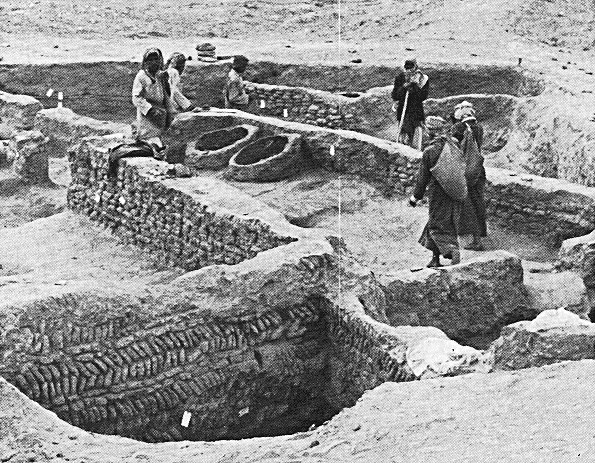|
Other Archaeological Sites / The Neolithic of the Levant (500 Page Book Online) Ancient Umm Hafriyat
NIPPUR REGIONAL PROJECT: UMM AL-HAFRIYAT by McGuire Gibson (1977-78) The site of Umm al-Hafriyat is located in the desert about fifteen miles to the east of Nippur and was excavated in 1977 as an adjunct to the Nippur operations. The reason for the excavations was in a sense salvage because the site was being excavated illegally by nomads. They had been looking for graves with Akkadian (circa 2300 B.C. and later) cylinder seals which they could sell or use for jewelry. Umm Hafriyat (Mother of Excavations) is a group of low mounds of different ages that lay along an ancient water course. A careful collection of potsherds from the surface showed that there was a small town here from as early as the Uruk Period (circa 3500 BC) until Seleucid times (circa 300 BC) but the settlement tended to shift rather than build up on one spot to form a large high mound. Unlike Nippur where there may be ten or more levels superimposed on one another, at Umm Hafriyat each mound has no more than three periods of occupation. Area C for example where the illegal digging was done has Akkadian buildings only a few centimeters below the surface. We carried out two major operations on the site. One was a stratigraphic pit at the highest point -- Area A. Here we discovered evidence of more than four meters depth of Isin-Larsa occupation (circa 2100-1900 B.C.) resting on a thin Ur III level (circa 2200 B.C.) that in turn lay on sterile soil. The finds from this pit, mostly sherds, correlated very well with similarly-dated material found at Nippur in the past two years thus verifying the basic pottery sequence that we have been establishing since 1972. The second major operation was the clearing of Akkadian buildings in a 20-meter square in Area C. Although damaged by illegal pits the buildings were intact enough to give good plans and to allow us to recover unusual amounts of seed, soil, bone, shell and other samples plus extraordinarily well-executed artifacts. All the walls in Area C are of plano-convex-shaped mud bricks usually laid flat but sometimes in herringbone fashion. There is not a bonded corner in the entire area and the walls were laid on whatever surface was available without leveling. The somewhat shoddy architecture was hidden beneath thick mud plaster. Most of the rooms we have opened seem to have been utilitarian and the floors are covered with thick beds of ash from the many ovens found in the rooms. Some of the ovens were for bread-baking but others contained bones of animals, birds and fish. One of the ovens also contained a very important Old Akkadian tablet. It is broken and therefore difficult to read but it is definitely a rare example of an early literary tablet, probably a love lyric. About ten other Old Akkadian tablets found in the rooms are of more usual characterre and record deliveries of flour, grain and other commodities from such places as Adab and Lagash. There are mentions in the tablets of "the temple" but no god's name is given nor is the town identified. |
